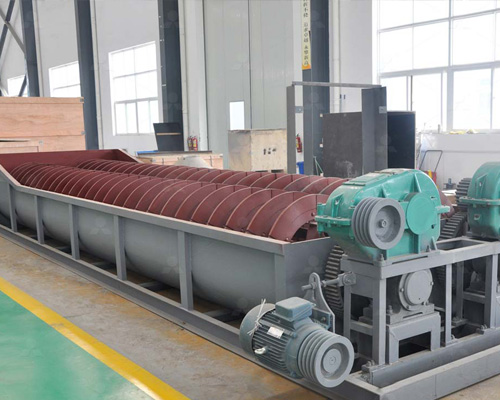
Spiral Classifier
Spiral classifiers are robust, versatile, and economical tools for solid-liquid separation and particle size control in various industries.Capacity:0.15-8TPH
Application: Widely used in combine with ball grinder into closed circulation for ore-sand separation in the ore separation plant; classify ore sand and fine sludge in gravity ore separation plant.
Chat online Call WhatsAppA spiral classifier is a type of industrial equipment widely used in mineral processing and material separation. It is designed to separate solid particles in a slurry based on differences in sedimentation rates, particle size, or density. The device consists of a spiral (rotating screw) submerged in a sloped tank or trough. As the spiral rotates, it lifts settled solids (e.g., coarse particles) from the bottom of the tank and discharges them at the top, while finer particles remain suspended and overflow with the liquid. Spiral classifiers are commonly employed in mining, sand and gravel plants, and construction industries for wet classification, dewatering, and desliming processes.

Key Features of Spiral Classifiers
- Simple Structure
- Composed of a spiral mechanism, trough, drive unit, and lifting device, making it easy to operate and maintain.
- Minimal moving parts reduce the risk of mechanical failure.
- High Capacity and Efficiency
- Capable of handling large volumes of slurry, making it ideal for continuous industrial operations.
- Efficiently separates coarse and fine particles through gravitational settling and mechanical lifting.
- Adjustable Operation
- The spiral’s rotation speed and immersion depth can be adjusted to optimize classification for different materials and particle sizes.
- Some models allow tilting of the trough to control retention time and separation accuracy.
- Low Energy Consumption
- Operates at relatively low power compared to other classification equipment (e.g., hydrocyclones).
- Durability
- Constructed with wear-resistant materials (e.g., rubber-lined or metal alloys) to withstand abrasive particles and harsh environments.
- Versatility
- Suitable for both classification and dewatering tasks.
- Used in closed-circuit grinding systems to control particle size in ball mills.
- Cost-Effective
- Low operational and maintenance costs over its lifespan.
Applications
- Mining: Separation of ore particles in mineral processing plants.
- Aggregate Industry: Washing and classifying sand, gravel, or crushed stone.
- Construction: Recycling water in concrete production by removing fine sediments.
- Environmental Engineering: Sludge dewatering in wastewater treatment.